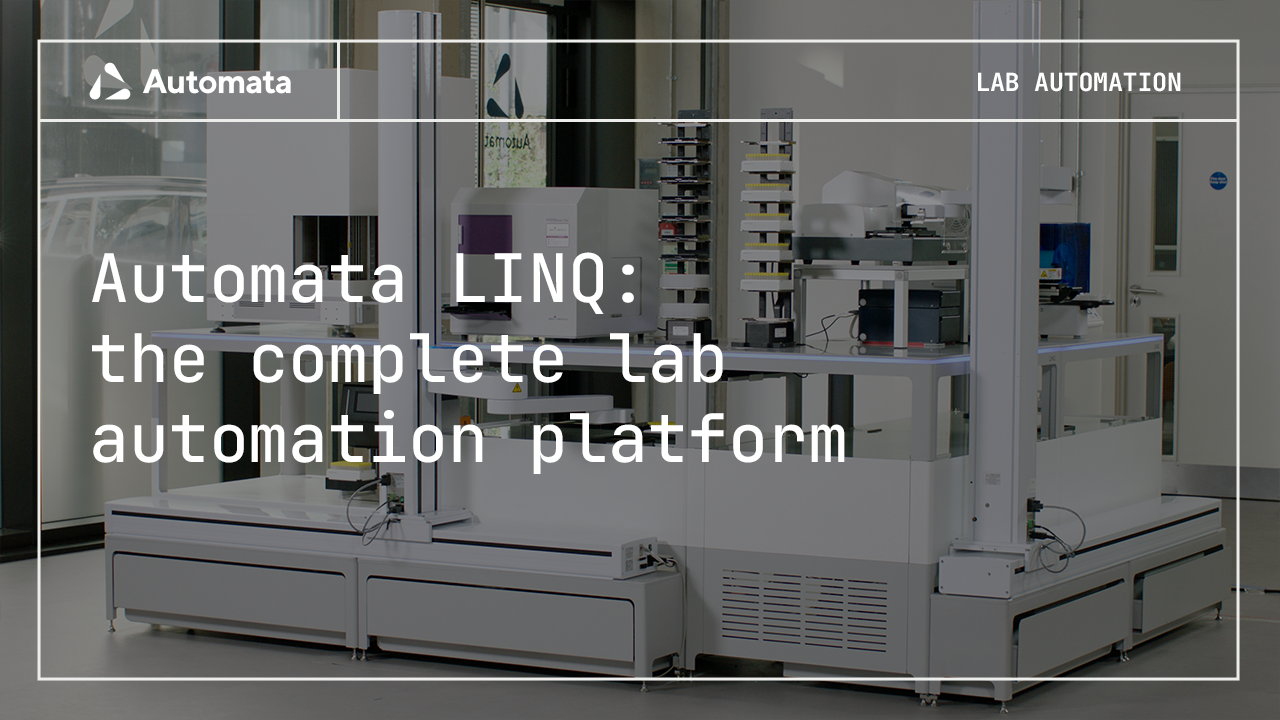In the rapidly evolving landscape of laboratory automation, labs have traditionally relied on on-premises solutions. However, the rise of secure and flexible cloud-first automation is ushering in a new era of highly responsive platforms that harness the transformative power of data and enable collaboration beyond physical and geographical boundaries.
Let’s explore cloud-first automation, why it’s the future for innovative laboratories, and the benefits it can bring compared to non-cloud solutions.
What is cloud-first automation?
With automation platforms like Automata’s LINQ, instruments, robotics, multi-point data collection, visualisation tools, human insight, and solving technologies come together to simplify and automate actions, freeing scientists’ time and improving the quality and scale of experiment results.
By choosing a platform with cloud-based software, the impact and benefits of automation are extended beyond physical boundaries. Researchers from anywhere within the organisation can readily access the capabilities of the labs’ cloud-connected workcells, advancing science and capital equipment ROI; while fully contextualised experimental results are stored in a unified data warehouse, also accessible from anywhere.
Cloud-first automation…
- Is highly flexible
- Is remotely accessible
- Removes data inconsistency issues
- Has 24/7 operational capabilities
- Can easily integrate with 3rd party software such as AI
- Is secure and cost-effective
- Allows better visibility and collaboration
- Is designed to meet regulatory requirements
- Can be domiciled in most regions around the world
- Is easy to use, regardless of automation experience
The benefits of cloud-first automation platforms
Cloud-first solutions are particularly helpful for those:
- Requiring high-quality and fully traceable data
- In collaborative environments
- Seeking efficiencies and maximum return on investment
- Who want the latest technology and secure updates
Let’s look at some of these areas in more detail.
1) How cloud-first automation…delivers quality, manageable data
Cloud-first lab automation drives the rapid generation of robust datasets for labs due to its ability to provide users with 24/7 secure global access to their systems. However, unlike on-premise solutions, cloud-based automation considers the purpose of this data throughout the whole lifecycle of experimentation, rather than simply generating more.
LINQ automates entire workflows, so every environmental condition for every machine is recorded at every step of the workflow, while all automation and user actions are also monitored.
This amount of data ensures fully contextualised workflow results, which can be segmented and interrogated for any number of reasons.
On-premise solutions may still rely on manual collection and transcription, especially if the automation lacks software connectivity, which may see scientists tending to and exporting information from any number of local, instrument-specific hubs. This introduces opportunities for data loss, data collection delays, and transcription errors. Even those that offer remote access may still be restricted by an inability to properly control workflows, limiting the reliability of results and the quality of the data they produce.
With platforms connected in the cloud, instruments are networked to one central location – in our case LINQ Cloud – so data can be collected automatically, instantly, and error-free, making it available immediately for analysis and global collaboration.
This automatic transfer and connectivity removes scientist workload capacity issues, so many more points of data can be easily collected, resulting in higher-quality metadata and improved experimental context.
It also makes gathering information needed by regulatory bodies like the FDA faster and more robust, while collaboration becomes easier, especially with those outside of your team.
2) How cloud-first automation…improves collaboration
It’s no secret that cloud-first solutions facilitate collaboration. Here at Automata, for example, we use Google Workspace to create and store documents with little to no issues – a world away from installing Office from a disc or CD on a local machine and sharing files via a USB stick! Just as traditional office spaces have made the switch from offline to online working as standard, so should labs.
Cloud-based lab automation gives entire companies access to fully connected networks of instrument resources, allowing multiple users to share equipment, execute workflows and view experiment results.
Collaborating on workflow management
Cloud-based automation like that provided by LINQ enables the use of a single shared platform to design, simulate, and interrogate experiments.
- Workflows can be designed, built and simulated by anyone at any time
- Run instructions can be uploaded, monitored, amended, and even downloaded from anywhere in the world
- And workflows can be fully scheduled, executed and even triaged – again remotely
In theory, you could easily have a separate person responsible for each part of workflow delivery as everything is secured with user permissions, validated by our scheduling engine, and actions recorded at user, workflow and instrument levels – with unlocked audit trails and log files available.
Collaborating with shared data
Because data collected by cloud-based automation platforms is transferred in real-time to your data lake of choice, everyone can work from a single source of data truth.
If you look to an automated future, cloud connectivity will allow entire organisations to access a world of contextualised information for multiple needs. This valuable repository of high-quality, traceable data provides the foundation for building multidisciplinary teams capable of reiterating at lightening speed.
3) How cloud-first automation…helps you maximise performance
For many, the driver of purchasing a lab automation platform is to improve productivity. Automating any process will give efficiencies, but doing so with an end-to-end, cloud-based solution will open up even more opportunities to impact performance.
Efficient workflows
Cloud-based lab automation helps users optimise workflows in a number of unique ways:
- Users can understand every conditional and constraint in play without needing to access individual on-site repositories
- By communicating directly with instruments the system can check that set-up, calibration, and conditions are 100% accurate against your workflow design and instructions
- Anyone from anywhere can jump in to support you, from tackling workflow design challenges on the fly to checking run instructions and predictions
- Resourcing gaps can be easily filled because everything is stored in the cloud, so one absent team member no longer means delayed activities
- Activity audit trails allow full interrogation of information, allowing further opportunities to identify and remove bottlenecks
- Online validation and remote-access workflow management means that you don’t have to wait for a workflow to complete only to discover it’s failed, and if issues occur, they can be tackled instantly by anyone, sharing the burden and keeping productivity on track
- Shared visualisations can offer inspiration from others and help users upskill
Maximised resources
With cloud-based lab automation that sees multiple systems connected to one online interface, it’s possible to plan and allocate resources much more effectively. For example:
- Resources can be ringfenced for particular clients, experiments, teams etc, with full visibility
- Capacity can be monitored, and loads can be shared more evenly
- Planned downtime is no longer a problem with tasks assigned to other instruments or workcells
- Instrument data helps track performance so equipment can be proactively maintained
Crucially, with cloud-based automation, this can all be done online, quickly, and transparently. There will be no more rushing to fix the machine, no more surprise downtime, and easy sharing of lab productivity information with leadership, even at a granular level if needed.
4) How cloud-first automation…ensures you’re up-to-date and future-ready
Artificial intelligence-ready
We believe cloud-first automation is the key to delivering what the industry needs, not only now but into the future.
Faster drug discovery, lower-cost sequencing, and better access to personalised therapeutics really hinge on true collaboration, done so without boundaries and underpinned by high-quality and scientifically valid data.
Many are turning to artificial intelligence to support these goals, and while AI in its many forms can certainly help, this presents a challenge at an industry scale as well as for those seeking to invest in lab automation platforms.
At an industry scale, AI is only as good as the quality and quantity of the data it was trained on and the size of the model. We already know that we have a data problem in life sciences, with too much of it being unreliable, untraceable, and uncontextualised.
Cloud-based lab automation is capable of generating and collecting vast sets of fully contextualised results by connecting all elements to a single data lake without error, resulting in large, unified, high-quality data sets that are exactly what AI models need.
Choosing a cloud-based option now will set you on the right path to integrating AI in the future.
5) How cloud-first automation…keeps you secure and operational
The widespread adoption of standard internet-based tools like remote viewers and online ticketing systems has made automatic updates, multi-layered security, and fast support from technology providers not just possible but expected. Having a cloud-based lab automation platform ensures you have access to all of this and more, faster and on a larger scale than ever.
- Instant online support reduces lab downtime, with response times reduced from days to less than hours
- Errors are reported back to operators instantly and via a remote interface, so you’re never out of control
- Remotely visible data logs make triaging issues easier for you or your automation provider
- Software updates can be applied seamlessly and at any time without an on-site appointment
- New equipment can be added easily with online download and application of drivers and integrations
The sensitivity of data in life sciences, as well as the value of materials used in experiments, of course, also puts security at the forefront of everyone’s minds, but that needn’t be the case.
To alleviate concern about cloud-based access, internet reliability, or disruption from updates, we’ve developed a number of ways to keep you online and safe. You should look for similar reassurances from any other provider of cloud-based scientific platforms.
- We have multiple tenancy options which can provide you with a unique, isolated cloud environment which can be domiciled in any of AWS’s regional locations, meaning updates are controlled by you, and more detailed and specific audit trails are possible
- Policies are unique to you, so you can decide whether you keep your software version locked or accept periodic updates
- Historical protocols, scheduling and security settings are pinned to workcells so that science doesn’t need to be re-validated after every update
- LINQ has an offline mode for added security in the event of an internet outage or local networking failure; workflows are able to stay running, and experimental data will continue to be collected for upload on reconnection. Already built workflows can continue to be executed as many times as you need, even offline
- User-based access permissions can be applied so you can have all profile types access LINQ Cloud without risking unauthorised changes
Cloud-first lab automation solutions are revolutionising the way laboratories operate, offering unparalleled flexibility, accessibility, and efficiency that traditional on-site systems simply cannot.
By embracing platforms like Automata’s LINQ, labs can automate complex workflows, collect and manage high-quality data seamlessly, and enhance collaboration across teams. These solutions not only improve productivity and resource utilisation but also ensure that labs remain agile, secure, and future-ready, capable of integrating emerging technologies like artificial intelligence whenever the need arises.
As the scientific landscape continues to evolve, adopting cloud-first automation will be essential. Get ahead of the curve and find a cloud-based solution today.
LINQ: The cloud-based automation from Automata
Automata’s LINQ platform houses and connects your instruments on a space-saving, robot-enabled lab bench, while allowing you to design, schedule and manage workflows remotely via cloud-based software.
Underpinned by your lifetime support team of scientists, engineers and automation experts, LINQ is the last automation solution you’ll ever buy.

